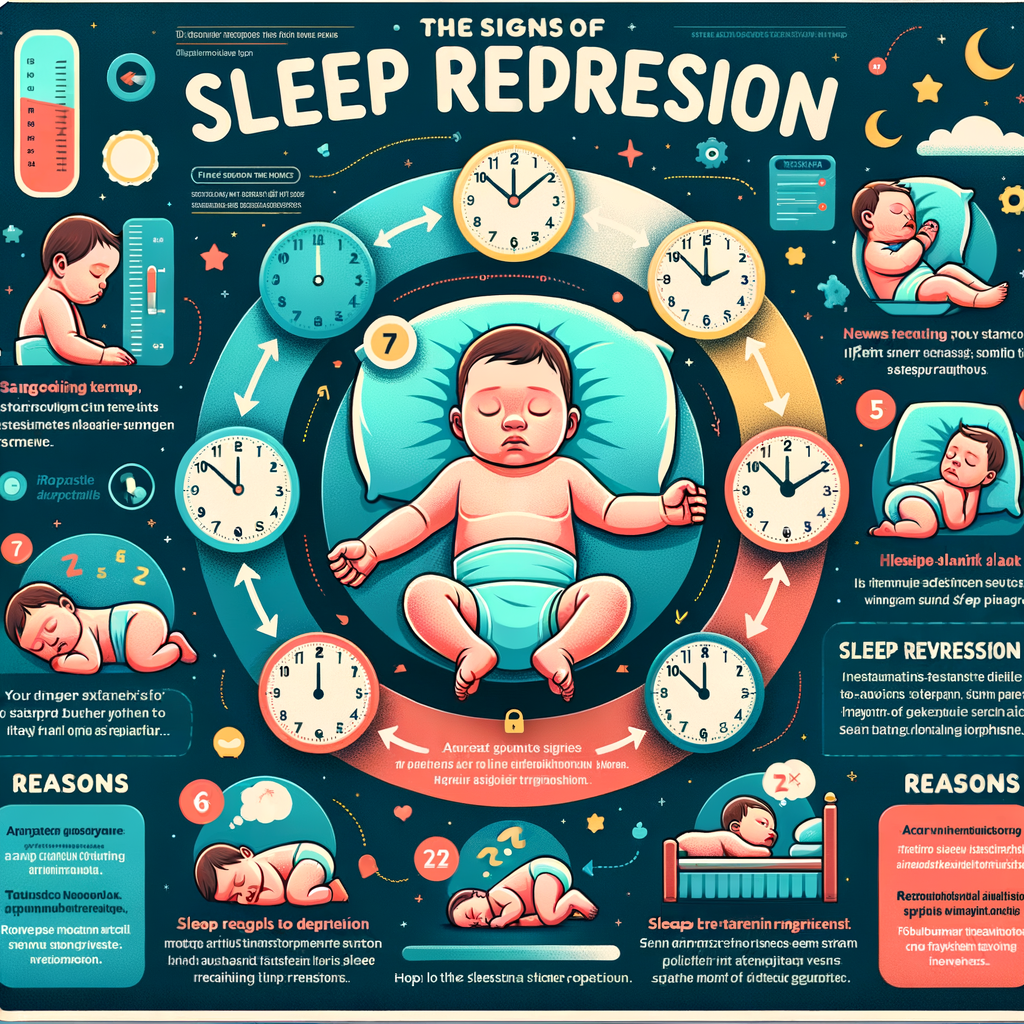
Understanding Infant Sleep Regression
When it comes to understanding your baby’s sleep patterns, it’s important to be aware of a phenomenon known as infant sleep regression. This term might sound complicated, but don’t worry, we’re here to break it down for you.
- Definition of Infant Sleep Regression
- Common misconceptions about baby sleep patterns
- Understanding the sleep cycle of babies
Sleep regression is a period when a baby who has been sleeping well suddenly starts waking up at night, and/or skips naps, for no apparent reason. This period can last for a few days to a few weeks. It’s a completely normal part of a baby’s development and is common in the first year of life.
Many parents believe that once their baby starts sleeping through the night, it’s smooth sailing from there. However, this is not always the case. Sleep regression is a normal part of a baby’s growth and development. It’s not a step backward but rather a sign that your baby is growing and developing.
Babies, just like adults, have sleep cycles. These cycles include periods of deep sleep and lighter Rapid Eye Movement (REM) sleep. Newborns spend more time in REM sleep, which is why they wake up more often. As they grow older, they start to spend more time in deep sleep. Understanding these cycles can help you better manage sleep regression periods.
Remember, every baby is unique and may experience sleep regression differently. It’s important to be patient and supportive during these periods. In the next section, we will explore the causes of sleep regression in infants.
Causes of Sleep Regression in Infants
Sleep regression in infants is a common occurrence that can leave many parents feeling puzzled and exhausted. Understanding the causes can help you better manage this phase. Here are some of the most common causes:
- Developmental Milestones
- Changes in Sleep Environment
- Illness or Teething
One of the primary causes of sleep regression in infants is the achievement of developmental milestones. As your baby grows and learns new skills, such as rolling over, sitting up, or crawling, their sleep patterns can be disrupted. This is because their little brains are busy processing all the new information, which can sometimes interfere with their sleep.
Any changes in your baby’s sleep environment can also lead to sleep regression. This could be a change in room temperature, a new crib, or even a vacation where they’re sleeping in a different place. Babies thrive on routine and consistency, so any changes can disrupt their sleep patterns.
Illness or teething can also cause sleep regression in infants. If your baby is feeling unwell or is experiencing the discomfort of teething, they may have trouble sleeping. It’s important to remember that this is a temporary phase and your baby’s sleep should return to normal once they’re feeling better.
In conclusion, sleep regression in infants can be caused by a variety of factors, including developmental milestones, changes in the sleep environment, and illness or teething. By understanding these causes, you can better manage your baby’s sleep regression and ensure they’re getting the rest they need.
Signs of Sleep Regression in Babies
When your baby’s sleep pattern suddenly changes, it can be a sign of sleep regression. This is a normal part of a child’s development, but it can be challenging for parents to manage. Here are some common signs of sleep regression in babies:
- Increased Night Waking
- Shorter Naps
- Changes in Appetite
One of the most common signs of sleep regression is increased night waking. If your baby was previously sleeping through the night and is now waking up frequently, it could be a sign of sleep regression. This can be due to various factors, such as growth spurts, teething, or changes in their environment.
Another sign of sleep regression is shorter naps. If your baby is not getting enough sleep at night, they may try to make up for it by taking more frequent, but shorter, naps during the day. This can disrupt their normal sleep schedule and make it harder for them to get the rest they need.
Changes in appetite can also be a sign of sleep regression. Some babies may eat more than usual to compensate for the energy they’re losing from not sleeping well. On the other hand, some babies may lose their appetite due to the stress and exhaustion of not getting enough sleep.
It’s important to remember that every baby is different, and these signs may not be present in all cases of sleep regression. However, if you notice any of these changes in your baby’s behavior, it’s worth discussing with your pediatrician to rule out any other potential health issues.
Dealing with Infant Sleep Regression
When your infant starts experiencing sleep regression, it can be a challenging time for both the baby and the parents. However, with the right approach, you can manage this phase effectively. One of the most effective strategies is sleep training.
Sleep Training for Infants
Sleep training is a method used to help infants learn to fall asleep on their own. It involves teaching your baby to self-soothe and establish a consistent sleep routine. Here are some key steps to successful sleep training:
-
Establishing a bedtime routine
Creating a consistent bedtime routine can signal to your baby that it’s time to sleep. This routine could include activities like a warm bath, reading a book, or singing a lullaby. The key is to keep the routine consistent and calming.
-
Teaching self-soothing skills
Self-soothing is a vital skill that helps your baby fall back asleep if they wake up during the night. You can encourage self-soothing by putting your baby in their crib while they’re drowsy but still awake, allowing them to fall asleep on their own.
-
Consistency is key
Consistency is crucial in sleep training. Stick to the same bedtime routine and sleep schedule every night. This consistency helps your baby understand what to expect, making it easier for them to settle into sleep.
Remember, every child is unique and what works for one might not work for another. It’s important to be patient and flexible as you navigate through this phase. With time and consistency, your baby will eventually learn to sleep through the night.
Tips for Managing Sleep Regression
Dealing with sleep regression can be a challenging task for parents. However, with patience, understanding, and a few practical strategies, it can be managed effectively. Here are some tips to help you navigate this phase:
- Stay Patient and Understanding
- Keep a Consistent Sleep Schedule
- Offer Comfort but Avoid Creating New Sleep Habits
Remember, your baby isn’t intentionally trying to keep you awake. They’re going through a developmental phase that’s disrupting their sleep. It’s essential to stay patient and understanding during this time. It’s okay to feel frustrated, but try to keep your cool and remember this phase will pass.
Consistency is key when it comes to managing sleep regression. Try to keep your baby’s bedtime and nap times as consistent as possible. This can help regulate their internal clock and make it easier for them to fall asleep and stay asleep.
It’s natural to want to comfort your baby when they’re upset. However, it’s important not to create new sleep habits that you’ll have to break later. For example, if your baby gets used to being rocked to sleep during this phase, they might start expecting it all the time. Instead, try to soothe your baby in their crib to help them learn to fall asleep on their own.
Remember, every baby is different, and what works for one might not work for another. It’s all about finding what works best for your baby and sticking to it. With patience and consistency, you’ll get through this challenging phase.
Case Studies: Real-Life Experiences with Infant Sleep Regression
Let’s delve into some real-life experiences of parents who have faced infant sleep regression. These case studies will provide practical insights into how they managed this challenging phase.
- Case Study 1: Dealing with Multiple Sleep Regressions
Meet Sarah, a first-time mother. Her baby, Lily, experienced multiple sleep regressions, starting from the age of four months. Sarah noticed that Lily, who used to sleep peacefully, started waking up frequently at night and had trouble falling back asleep.
Feeling overwhelmed, Sarah sought advice from her pediatrician. She learned that sleep regressions are a normal part of a baby’s development. She was advised to maintain a consistent bedtime routine, which included a warm bath, a bedtime story, and a lullaby. Over time, Lily’s sleep patterns improved, and she started sleeping through the night again.
- Case Study 2: Overcoming Sleep Regression with Sleep Training
John and Emily, parents of six-month-old Ethan, were struggling with his sleep regression. Ethan would wake up every two hours, leaving his parents exhausted.
They decided to try sleep training. They chose the “gradual extinction” method, which involved letting Ethan cry for a few minutes before comforting him. This method was challenging at first, but after a week, Ethan started to self-soothe and sleep for longer periods.
- Case Study 3: Managing Sleep Regression in Twins
Twins can be twice the joy and twice the challenge, as Laura and Mike discovered. Their twin girls, Ava and Mia, hit a sleep regression at the same time. The parents found themselves up multiple times a night, tending to one baby or the other.
They decided to synchronize the twins’ sleep schedules. They put the twins to bed at the same time, and when one woke up, they would wake the other for feeding. This strategy helped manage the sleep regression and allowed Laura and Mike to get some much-needed rest.
These case studies show that while infant sleep regression can be a challenging phase, it is manageable with patience, consistency, and the right strategies. Remember, every baby is unique, and what works for one may not work for another. It’s important to find a solution that suits your baby’s needs and your family’s lifestyle.
Key Takeaways: Understanding and Managing Infant Sleep Regression
As we wrap up our discussion on infant sleep regression, let’s summarize the key points we’ve covered. These takeaways will help you understand and manage this common developmental phase more effectively.
- Infant sleep regression is a normal part of development:
Firstly, it’s important to remember that infant sleep regression is a normal part of a baby’s development. It’s a sign that your baby’s sleep patterns are maturing and changing. This phase can be challenging for parents, but it’s a temporary stage that all infants go through. In fact, according to a study by the American Academy of Pediatrics, sleep regression typically occurs around 4 months, 8 months, and 18 months of age.
- Consistent routines and patience can help manage sleep regression:
Secondly, maintaining a consistent bedtime routine can help manage sleep regression. This includes activities like bathing, reading a book, and singing lullabies. Patience is also crucial during this phase. Remember, your baby isn’t purposefully trying to disrupt your sleep. They’re simply adjusting to new developmental milestones. So, take a deep breath, and know that this phase will pass.
- Seek professional help if sleep regression persists or causes significant distress:
Lastly, if sleep regression persists for more than a few weeks or causes significant distress for you or your baby, it’s time to seek professional help. A pediatrician or a sleep consultant can provide guidance and strategies to help manage this phase. Remember, you’re not alone in this journey, and there’s always help available.
In conclusion, understanding and managing infant sleep regression can be a challenge, but with patience, consistency, and professional guidance, you can navigate this phase successfully. Remember, every baby is unique, and what works for one might not work for another. So, be flexible, keep trying different strategies, and most importantly, take care of yourself too.














